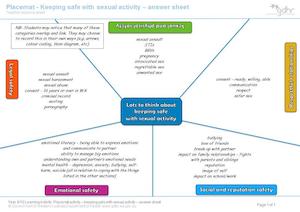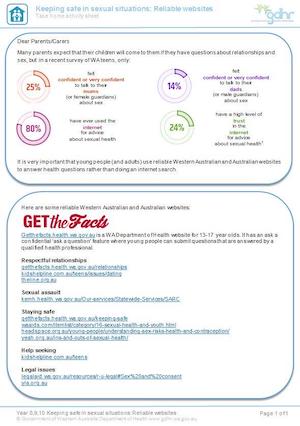
What do you think 'ramification' means? Use a dictionary if you don't know.

Students explore legal, physical, social and emotional safety, and respectful relationships using a placemat strategy and the Laugh and learn video as a stimulus.
Explores the importance of communicating with a partner about readiness for sex, consent and
ACPPS093: Skills and strategies to promote respectful relationships
International technical guidance on sexuality education
Optional: Take home activity_reliable RSE websites
Teaching tip: A group agreement must be established before any Relationships and Sexuality Education (RSE) program begins to ensure a safe learning environment. Read Essential Tool: Establishing a group agreement for tips on how to create one and what to include.
"In this video there are some words and phrases that need some thinking about and discussing before we get to see the video."
What do you think 'ramification' means? Use a dictionary if you don't know.
(Consequence, result, aftermath, outcome, effect.)
Thinking about the topic of 'staying safe in a sexual situation' - what do you think would be covered in a 'proper talk'?
(e.g., Communicating about individual wants; consent; STI and pregnancy prevention.)
What do you understand 'safe sex' measures to be?
(Using a condom to prevent STIs and/or pregnancy and using a contraceptive method to prevent pregnancy.)
"The term 'safe sex' and 'safer sex' are often used interchangeably. In this video the term 'safe sex' is used, however, the more accurate term is 'safer sex' as no sexual activity is 100% safe."
For a more detailed explanation see Safer sex (external link) and What is safer sex? (external link).

What do you think of the use of humour in this video?
Does it help get information across? How?
What is the message/information you got from this video?
(e.g. it is important to talk about safer sex beforehand; both partners need to be ready; the age of consent in WA is 16; partners should be aware of what each other want; consent is vital)
"While humour is useful and we can laugh at some aspects, there is a serious side to keeping safe that we need to look at. We're going to look at some of the important considerations around, and possible 'ramifications' (consequences) of, sexual activity."
Ask:
There were a number of positive key words you may have seen or heard in the video. What were they? (Give clues by writing these words with some letters missing.)
So why is it important to talk about safe sex beforehand?
(e.g., ready; comfortable; can be difficult because it is out of comfort zone; both need to be aware of each other's expectations.)
"There are several aspects to keeping safe in sexual situations that need to be considered.
There are different areas that need to be considered when people are thinking about keeping themselves and their partners safe in sexual situations. As we have discussed, safety and wellbeing related to sexual activity is about more than just STI and pregnancy prevention. It is important to think about the issues and impacts related to all areas:
Many of the issues and consequences considered in each area overlap and link with other areas.
Teaching tip: For essential information about consent, safer sex and taking selfies go to the Youth Law Australia website (external site) and Get the Facts - Sex and the law (external site).
Teaching strategy: Placemat activity
In groups of 4 students complete Student activity sheet: Keeping safe with sexual activity. Have each group discuss and record possible issues and ramifications associated with different aspects of keeping safe in sexual situations:

Provide students with the Take home activity: Reliable RSE websites (electronic copy if possible). Remind them that it is best to use credible Western Australian and Australian websites to answer health questions rather than doing an internet search.


Backgroud teacher note: Health promoting schools framework.
Partnerships with parents
Partnerships with school staff